Engineering Report: 3D Printing, Additive Manufacturing Analysis
VerifiedAdded on 2020/05/04
|10
|2255
|338
Report
AI Summary
This report provides a comprehensive overview of 3D printing, also known as additive manufacturing. It begins by defining 3D printing and its role in creating 3D objects through layer-by-layer material addition, contrasting it with subtractive manufacturing. The report categorizes various 3D printing processes, including material extrusion, direct energy deposition, powder bed fusion, binder jetting, material jetting, sheet lamination, and vat photopolymerization. It then analyzes the suitability of 3D printing for both low and high-volume production, highlighting its cost-effectiveness and design freedom. The report explores valuable applications of 3D printing, such as in hearing aids and custom-fit products, and offers a forecast for its future development. Furthermore, it discusses how 3D printing is making traditional manufacturing obsolete and its effects on the industry. The report concludes with recommendations, such as avoiding printing on curved surfaces and enclosed hollow features, and suggests areas for improvement in the 3D printing process. The report is a valuable resource for understanding the current and future impact of 3D printing technology.
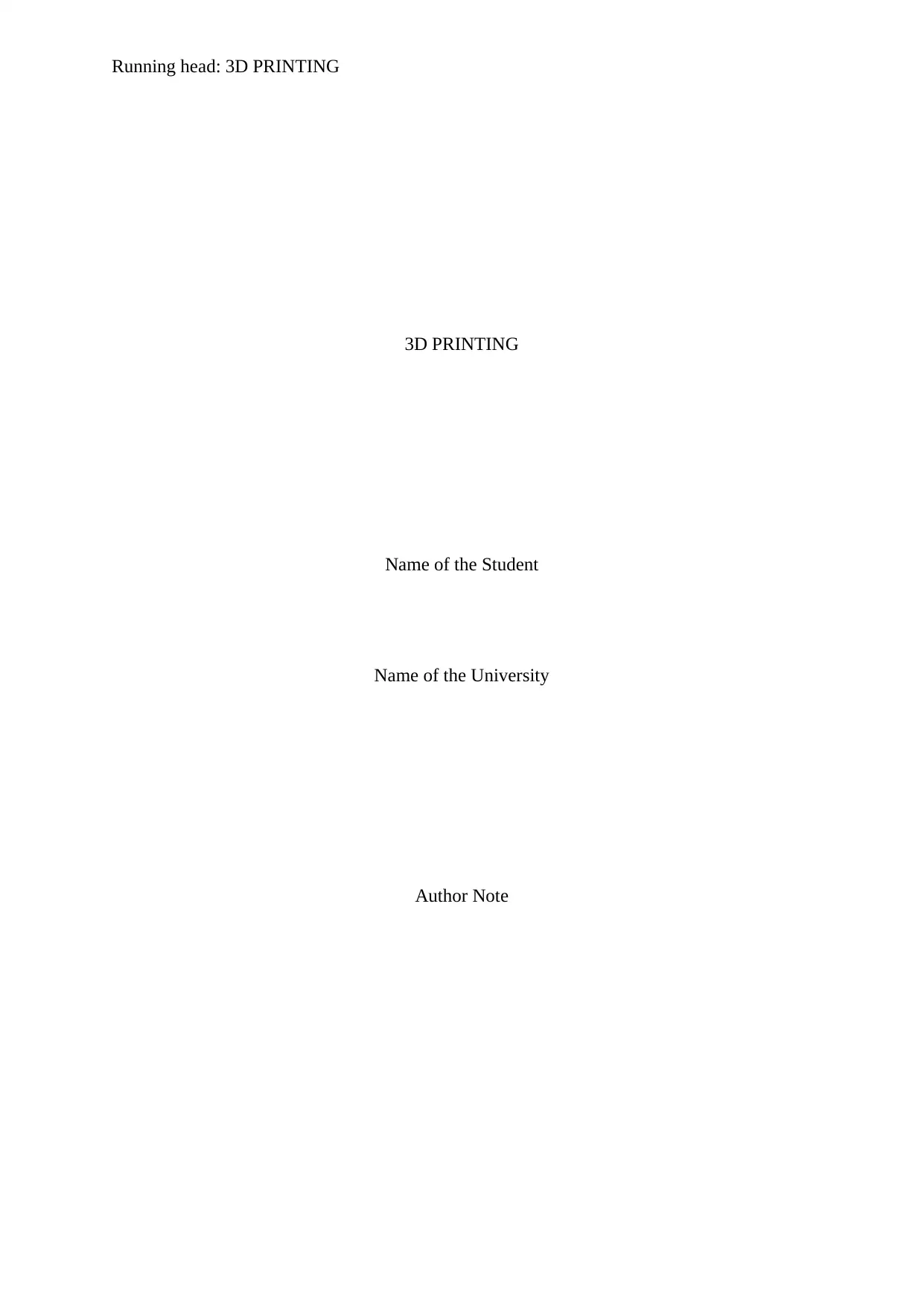
Running head: 3D PRINTING
3D PRINTING
Name of the Student
Name of the University
Author Note
3D PRINTING
Name of the Student
Name of the University
Author Note
Paraphrase This Document
Need a fresh take? Get an instant paraphrase of this document with our AI Paraphraser
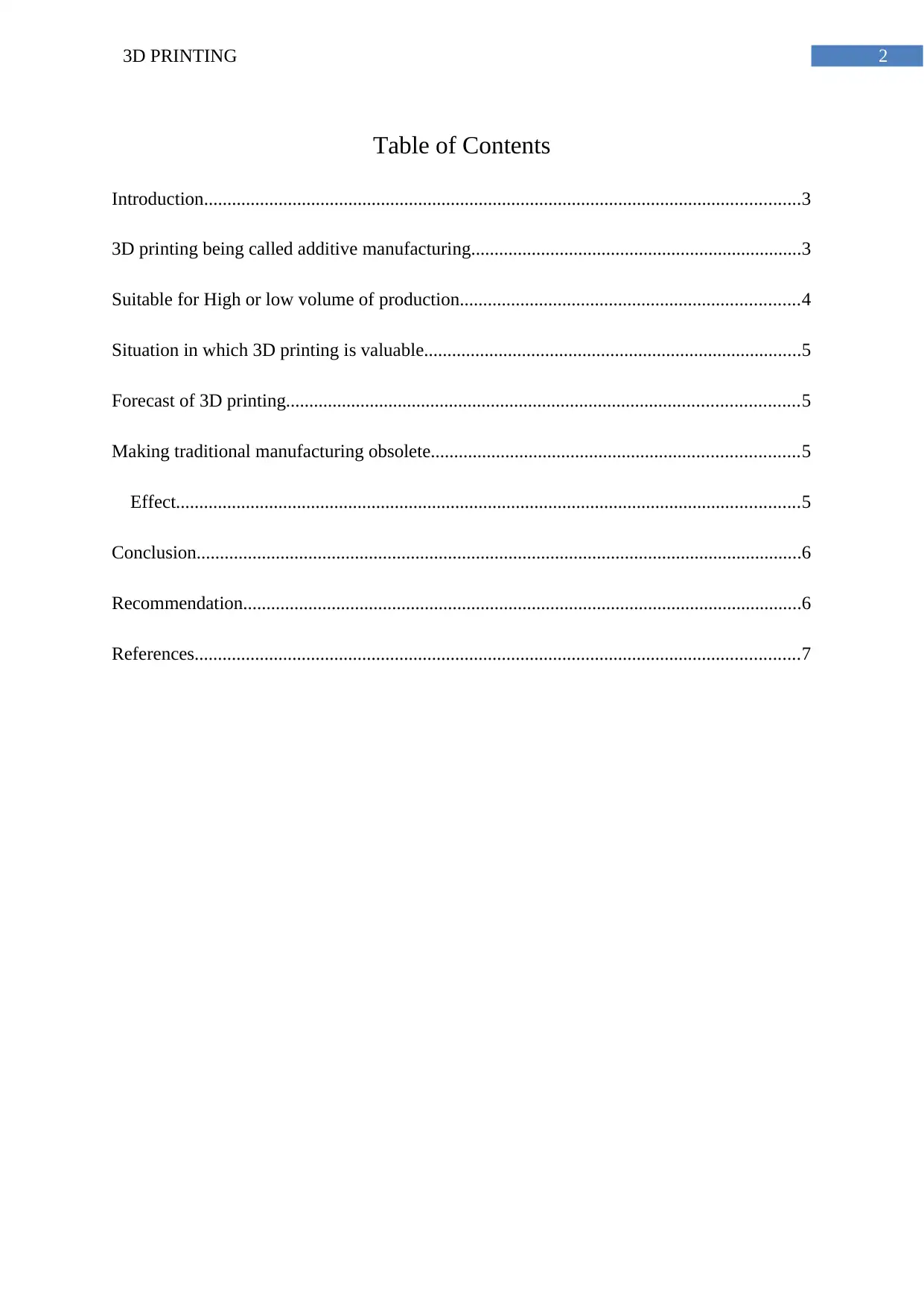
23D PRINTING
Table of Contents
Introduction................................................................................................................................3
3D printing being called additive manufacturing.......................................................................3
Suitable for High or low volume of production.........................................................................4
Situation in which 3D printing is valuable.................................................................................5
Forecast of 3D printing..............................................................................................................5
Making traditional manufacturing obsolete...............................................................................5
Effect......................................................................................................................................5
Conclusion..................................................................................................................................6
Recommendation........................................................................................................................6
References..................................................................................................................................7
Table of Contents
Introduction................................................................................................................................3
3D printing being called additive manufacturing.......................................................................3
Suitable for High or low volume of production.........................................................................4
Situation in which 3D printing is valuable.................................................................................5
Forecast of 3D printing..............................................................................................................5
Making traditional manufacturing obsolete...............................................................................5
Effect......................................................................................................................................5
Conclusion..................................................................................................................................6
Recommendation........................................................................................................................6
References..................................................................................................................................7
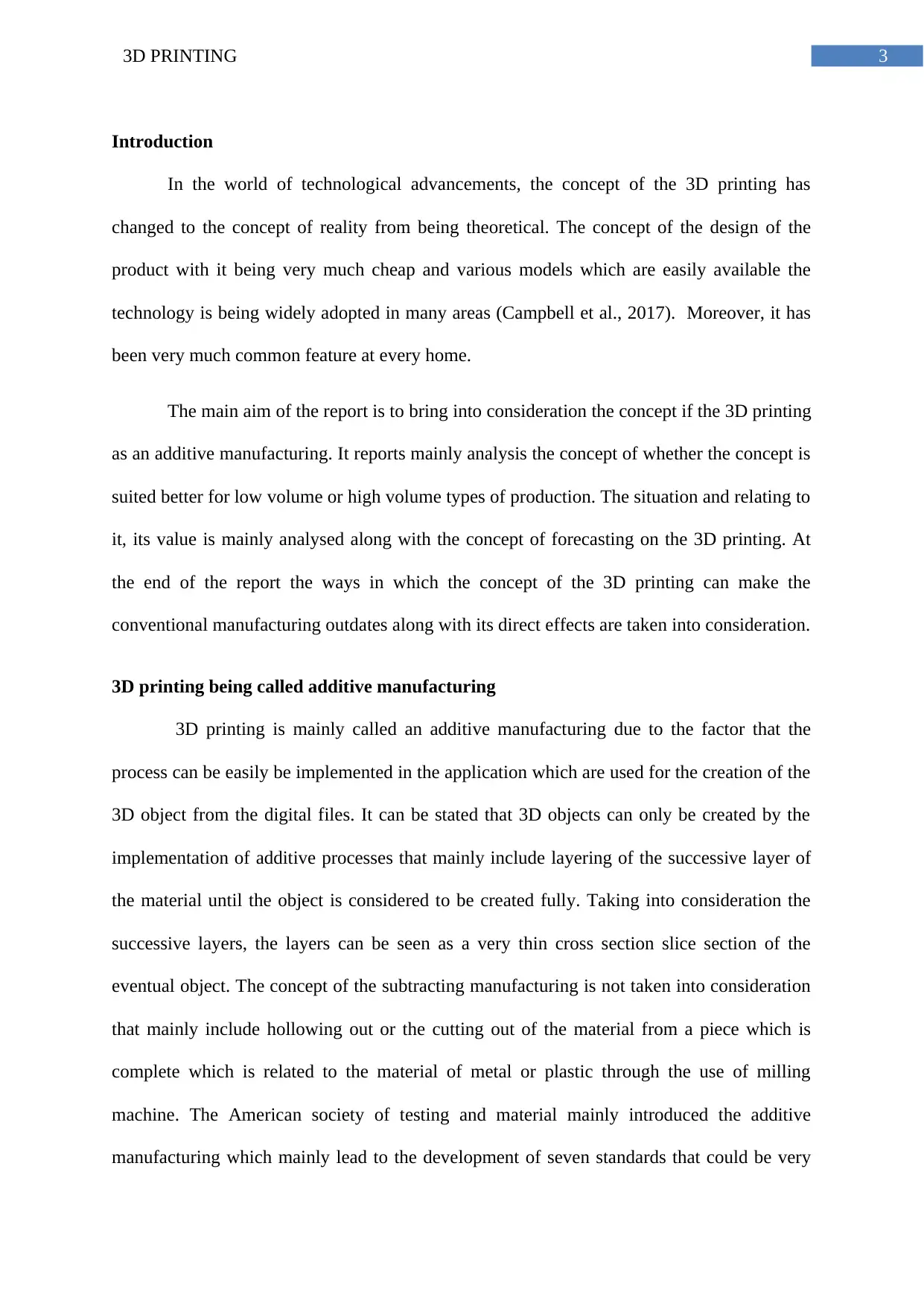
33D PRINTING
Introduction
In the world of technological advancements, the concept of the 3D printing has
changed to the concept of reality from being theoretical. The concept of the design of the
product with it being very much cheap and various models which are easily available the
technology is being widely adopted in many areas (Campbell et al., 2017). Moreover, it has
been very much common feature at every home.
The main aim of the report is to bring into consideration the concept if the 3D printing
as an additive manufacturing. It reports mainly analysis the concept of whether the concept is
suited better for low volume or high volume types of production. The situation and relating to
it, its value is mainly analysed along with the concept of forecasting on the 3D printing. At
the end of the report the ways in which the concept of the 3D printing can make the
conventional manufacturing outdates along with its direct effects are taken into consideration.
3D printing being called additive manufacturing
3D printing is mainly called an additive manufacturing due to the factor that the
process can be easily be implemented in the application which are used for the creation of the
3D object from the digital files. It can be stated that 3D objects can only be created by the
implementation of additive processes that mainly include layering of the successive layer of
the material until the object is considered to be created fully. Taking into consideration the
successive layers, the layers can be seen as a very thin cross section slice section of the
eventual object. The concept of the subtracting manufacturing is not taken into consideration
that mainly include hollowing out or the cutting out of the material from a piece which is
complete which is related to the material of metal or plastic through the use of milling
machine. The American society of testing and material mainly introduced the additive
manufacturing which mainly lead to the development of seven standards that could be very
Introduction
In the world of technological advancements, the concept of the 3D printing has
changed to the concept of reality from being theoretical. The concept of the design of the
product with it being very much cheap and various models which are easily available the
technology is being widely adopted in many areas (Campbell et al., 2017). Moreover, it has
been very much common feature at every home.
The main aim of the report is to bring into consideration the concept if the 3D printing
as an additive manufacturing. It reports mainly analysis the concept of whether the concept is
suited better for low volume or high volume types of production. The situation and relating to
it, its value is mainly analysed along with the concept of forecasting on the 3D printing. At
the end of the report the ways in which the concept of the 3D printing can make the
conventional manufacturing outdates along with its direct effects are taken into consideration.
3D printing being called additive manufacturing
3D printing is mainly called an additive manufacturing due to the factor that the
process can be easily be implemented in the application which are used for the creation of the
3D object from the digital files. It can be stated that 3D objects can only be created by the
implementation of additive processes that mainly include layering of the successive layer of
the material until the object is considered to be created fully. Taking into consideration the
successive layers, the layers can be seen as a very thin cross section slice section of the
eventual object. The concept of the subtracting manufacturing is not taken into consideration
that mainly include hollowing out or the cutting out of the material from a piece which is
complete which is related to the material of metal or plastic through the use of milling
machine. The American society of testing and material mainly introduced the additive
manufacturing which mainly lead to the development of seven standards that could be very
⊘ This is a preview!⊘
Do you want full access?
Subscribe today to unlock all pages.

Trusted by 1+ million students worldwide

43D PRINTING
much helpful in order to classify the additive manufacturing into mainly seven categories.
These processes are listed below:
Material extrusion: There are mainly three technologies which can be related to its which
are FFF, FDM and contour crafting and this can be used to implement and add materials
and the creation of the object which are represented as an additive evidence.
Direct deposition of energy: This concept is mainly used in the manufacture of high tech
industry and applications. It comprises of deposits of the metal powder on the surface and
the multi- axis hand of the robotics which is connected to the nozzle which is used to the
creation of the object (Weller, Kleer & Piller, 2015).
Powder bed fusion: there are mainly two types of additive process that are used under the
process in order to create 3D objects which includes the SLS (selective laser sintering),
DMLS (Direct metal laser sintering).
Binder jetting: in this section liquid binder and material of powder base are used. In the
chamber this powder is mainly spread equally and the addition of glue is made which
mainly strengthen the objects.
Material jetting: the basic working principle is related very much similar to the concept of
the inkjet paper printer in which the material is basically applied through the use of a
small nozzle. The only difference which is applied to the concept is that application is
mainly done in a layer by layer manner in order to build the 3D object and after the
process it is mainly hardened by the exposure of the UV light (Loo, Chua & Pumera,
2017).
Sheet lamination: bounded by external forces it mainly involves material which are in the
shape of the sheet.
Vat photo – Polymerization
much helpful in order to classify the additive manufacturing into mainly seven categories.
These processes are listed below:
Material extrusion: There are mainly three technologies which can be related to its which
are FFF, FDM and contour crafting and this can be used to implement and add materials
and the creation of the object which are represented as an additive evidence.
Direct deposition of energy: This concept is mainly used in the manufacture of high tech
industry and applications. It comprises of deposits of the metal powder on the surface and
the multi- axis hand of the robotics which is connected to the nozzle which is used to the
creation of the object (Weller, Kleer & Piller, 2015).
Powder bed fusion: there are mainly two types of additive process that are used under the
process in order to create 3D objects which includes the SLS (selective laser sintering),
DMLS (Direct metal laser sintering).
Binder jetting: in this section liquid binder and material of powder base are used. In the
chamber this powder is mainly spread equally and the addition of glue is made which
mainly strengthen the objects.
Material jetting: the basic working principle is related very much similar to the concept of
the inkjet paper printer in which the material is basically applied through the use of a
small nozzle. The only difference which is applied to the concept is that application is
mainly done in a layer by layer manner in order to build the 3D object and after the
process it is mainly hardened by the exposure of the UV light (Loo, Chua & Pumera,
2017).
Sheet lamination: bounded by external forces it mainly involves material which are in the
shape of the sheet.
Vat photo – Polymerization
Paraphrase This Document
Need a fresh take? Get an instant paraphrase of this document with our AI Paraphraser
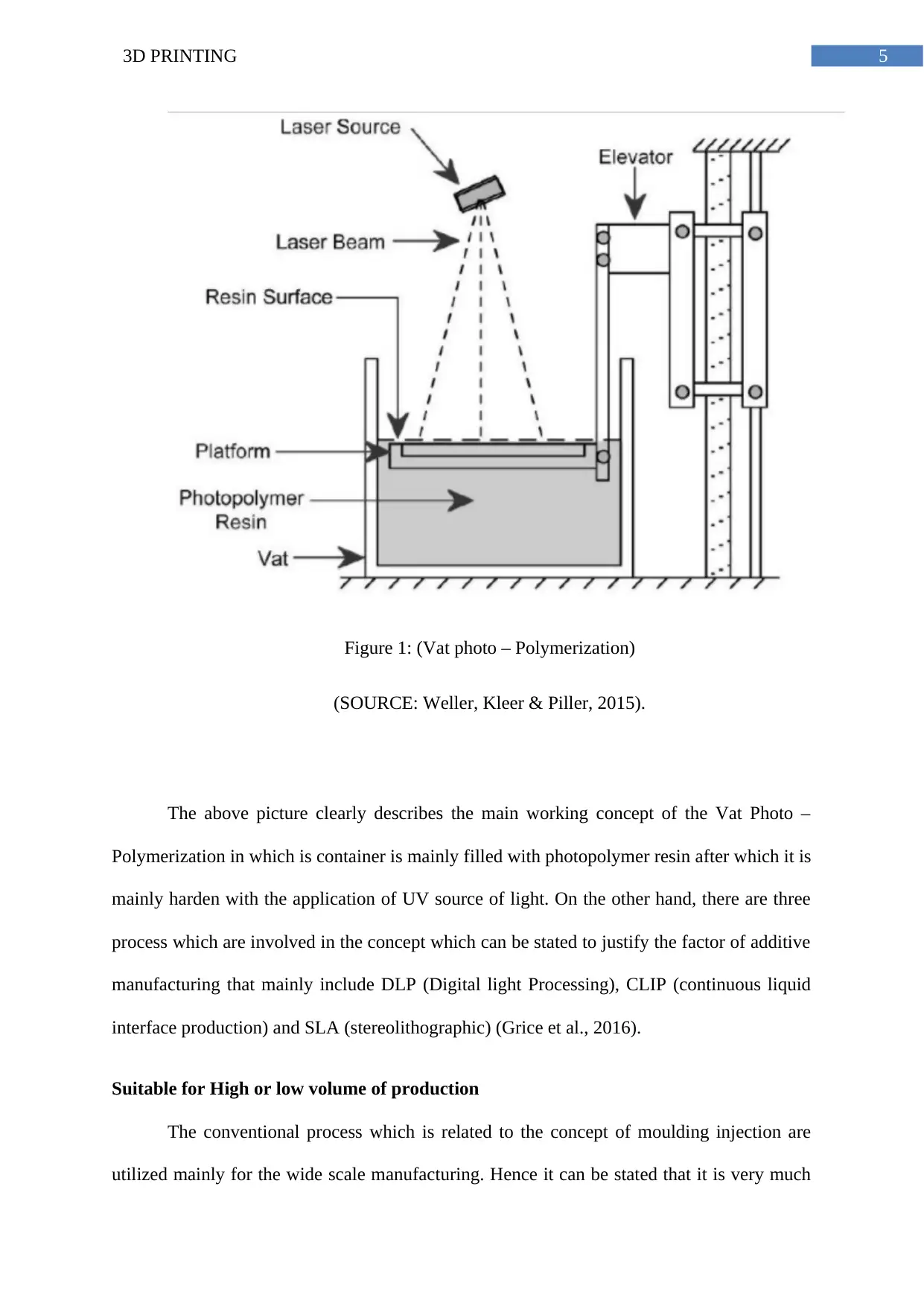
53D PRINTING
Figure 1: (Vat photo – Polymerization)
(SOURCE: Weller, Kleer & Piller, 2015).
The above picture clearly describes the main working concept of the Vat Photo –
Polymerization in which is container is mainly filled with photopolymer resin after which it is
mainly harden with the application of UV source of light. On the other hand, there are three
process which are involved in the concept which can be stated to justify the factor of additive
manufacturing that mainly include DLP (Digital light Processing), CLIP (continuous liquid
interface production) and SLA (stereolithographic) (Grice et al., 2016).
Suitable for High or low volume of production
The conventional process which is related to the concept of moulding injection are
utilized mainly for the wide scale manufacturing. Hence it can be stated that it is very much
Figure 1: (Vat photo – Polymerization)
(SOURCE: Weller, Kleer & Piller, 2015).
The above picture clearly describes the main working concept of the Vat Photo –
Polymerization in which is container is mainly filled with photopolymer resin after which it is
mainly harden with the application of UV source of light. On the other hand, there are three
process which are involved in the concept which can be stated to justify the factor of additive
manufacturing that mainly include DLP (Digital light Processing), CLIP (continuous liquid
interface production) and SLA (stereolithographic) (Grice et al., 2016).
Suitable for High or low volume of production
The conventional process which is related to the concept of moulding injection are
utilized mainly for the wide scale manufacturing. Hence it can be stated that it is very much

63D PRINTING
suited for volume production which is high. It can be stated to the reshaping of the
development and the product manufacturing (Weller, Kleer & Piller, 2015). By the
implementation of the process of 3D printing, the designers and the engineers are able to save
money. Taking into account the save of time, it can be regarded as very much beneficial.
Regarding the low volume manufacture, the labour intensive and the portion of the
cost has been the tooling production. The printers which are 3D are able to remove the
expense part since it eradicates the necessity for the production of the tools that has been
cutting the lead time and the labour (Ju et al., 2017)
Regarding the high volume manufacture, there are many benefits that are inherent to
the process. this mainly involve the capacity which is related to the production of the parts
which are custom with no cost of upfront virtually. Moreover, it can be stated to be capable
of producing the shape that are uneconomical and impossible (Radenkovic, Solouk &
Seifalian, 2016).
Situation in which 3D printing is valuable
The situation in which the 3D printing is most valuable mainly depends on how the
term value is defined (Xing, Zheng & Duan, 2015). The largest market of the 3D printing is
currently based on application of the customer has been the hearing aids. The ear hearing aids
are mainly created through the implementation of the 3D printing.
The plastic implants and the implants have been possessing potentially higher orders
in the market. Taking into consideration other unrealized market scenario which is related to
the 3D printing cartilage, can be considered to be decide away from the commercialization.
The products which are related to custom fit has been the outstanding project which is
related to business for those customer who have been searching for the 3D printing. The
suited for volume production which is high. It can be stated to the reshaping of the
development and the product manufacturing (Weller, Kleer & Piller, 2015). By the
implementation of the process of 3D printing, the designers and the engineers are able to save
money. Taking into account the save of time, it can be regarded as very much beneficial.
Regarding the low volume manufacture, the labour intensive and the portion of the
cost has been the tooling production. The printers which are 3D are able to remove the
expense part since it eradicates the necessity for the production of the tools that has been
cutting the lead time and the labour (Ju et al., 2017)
Regarding the high volume manufacture, there are many benefits that are inherent to
the process. this mainly involve the capacity which is related to the production of the parts
which are custom with no cost of upfront virtually. Moreover, it can be stated to be capable
of producing the shape that are uneconomical and impossible (Radenkovic, Solouk &
Seifalian, 2016).
Situation in which 3D printing is valuable
The situation in which the 3D printing is most valuable mainly depends on how the
term value is defined (Xing, Zheng & Duan, 2015). The largest market of the 3D printing is
currently based on application of the customer has been the hearing aids. The ear hearing aids
are mainly created through the implementation of the 3D printing.
The plastic implants and the implants have been possessing potentially higher orders
in the market. Taking into consideration other unrealized market scenario which is related to
the 3D printing cartilage, can be considered to be decide away from the commercialization.
The products which are related to custom fit has been the outstanding project which is
related to business for those customer who have been searching for the 3D printing. The
⊘ This is a preview!⊘
Do you want full access?
Subscribe today to unlock all pages.

Trusted by 1+ million students worldwide

73D PRINTING
advantage which is achieved from the concept is that it mainly fits the customer demand the
way they need it (Ju et al., 2017)
Forecast of 3D printing
The leading research which is being conducted is mainly in the field of whether to
conduct the research according to in house capabilities, the reason and outsourcing. Taking
into account the organization which are committed for the 3D printing the outcomes has been
the part of ensuring that the me path of the peers and the field of various challenges for the
adoption (Xing, Zheng & Duan, 2015). A competitive advantage is mainly achieved by the
usage of the security printing in order to achieve manufacturing of the product which has
been coming out of the current competitive advantage.
Making traditional manufacturing obsolete
There have been ways in which the 3D printing aspects is obsoleting the concept of
the traditional manufacturing. The concept of the 3D printing has been speeding the design
which is related to the product and the overall speed of the business. Moreover, it has been
creating a concept of object dense which is devoid of discernible layering and the concept of
monolithic. Moreover, it can be stated that the technology directly provides greater freedom
in the design and the innovation which is related to the spur. The technology has been
producing the project in a fast and comparatively much costlier (Xing, Zheng & Duan, 2015).
Effect
The implementation has been providing the concept of the manufacture as a service
tool, which is very much same as the software as a service. The reduction of the waste is also
encountered and the development of the resources which are being used in the concept. The
left over material after the implementation of any process can be used in different sectors and
the reuse factor is taken into account.
advantage which is achieved from the concept is that it mainly fits the customer demand the
way they need it (Ju et al., 2017)
Forecast of 3D printing
The leading research which is being conducted is mainly in the field of whether to
conduct the research according to in house capabilities, the reason and outsourcing. Taking
into account the organization which are committed for the 3D printing the outcomes has been
the part of ensuring that the me path of the peers and the field of various challenges for the
adoption (Xing, Zheng & Duan, 2015). A competitive advantage is mainly achieved by the
usage of the security printing in order to achieve manufacturing of the product which has
been coming out of the current competitive advantage.
Making traditional manufacturing obsolete
There have been ways in which the 3D printing aspects is obsoleting the concept of
the traditional manufacturing. The concept of the 3D printing has been speeding the design
which is related to the product and the overall speed of the business. Moreover, it has been
creating a concept of object dense which is devoid of discernible layering and the concept of
monolithic. Moreover, it can be stated that the technology directly provides greater freedom
in the design and the innovation which is related to the spur. The technology has been
producing the project in a fast and comparatively much costlier (Xing, Zheng & Duan, 2015).
Effect
The implementation has been providing the concept of the manufacture as a service
tool, which is very much same as the software as a service. The reduction of the waste is also
encountered and the development of the resources which are being used in the concept. The
left over material after the implementation of any process can be used in different sectors and
the reuse factor is taken into account.
Paraphrase This Document
Need a fresh take? Get an instant paraphrase of this document with our AI Paraphraser
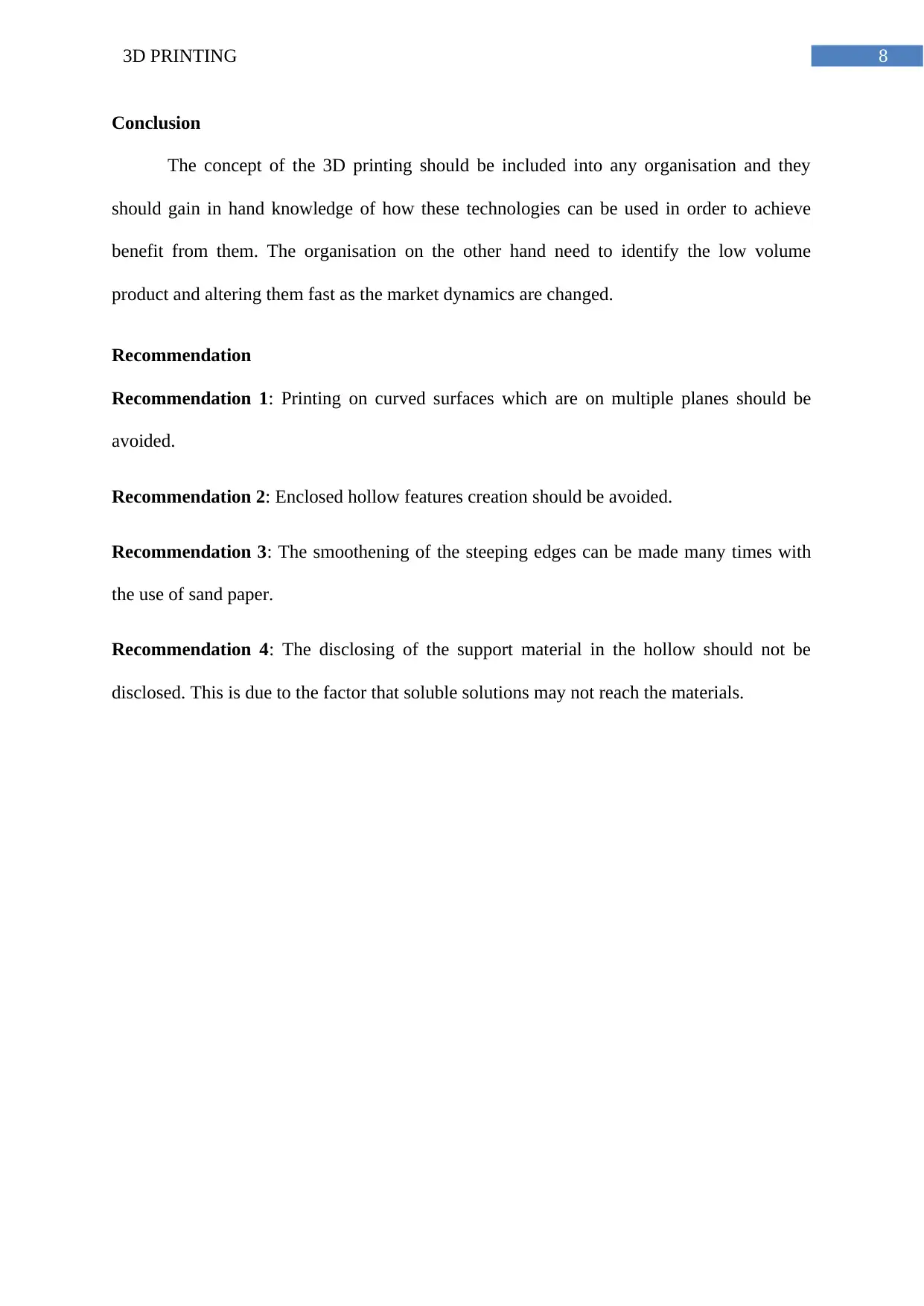
83D PRINTING
Conclusion
The concept of the 3D printing should be included into any organisation and they
should gain in hand knowledge of how these technologies can be used in order to achieve
benefit from them. The organisation on the other hand need to identify the low volume
product and altering them fast as the market dynamics are changed.
Recommendation
Recommendation 1: Printing on curved surfaces which are on multiple planes should be
avoided.
Recommendation 2: Enclosed hollow features creation should be avoided.
Recommendation 3: The smoothening of the steeping edges can be made many times with
the use of sand paper.
Recommendation 4: The disclosing of the support material in the hollow should not be
disclosed. This is due to the factor that soluble solutions may not reach the materials.
Conclusion
The concept of the 3D printing should be included into any organisation and they
should gain in hand knowledge of how these technologies can be used in order to achieve
benefit from them. The organisation on the other hand need to identify the low volume
product and altering them fast as the market dynamics are changed.
Recommendation
Recommendation 1: Printing on curved surfaces which are on multiple planes should be
avoided.
Recommendation 2: Enclosed hollow features creation should be avoided.
Recommendation 3: The smoothening of the steeping edges can be made many times with
the use of sand paper.
Recommendation 4: The disclosing of the support material in the hollow should not be
disclosed. This is due to the factor that soluble solutions may not reach the materials.
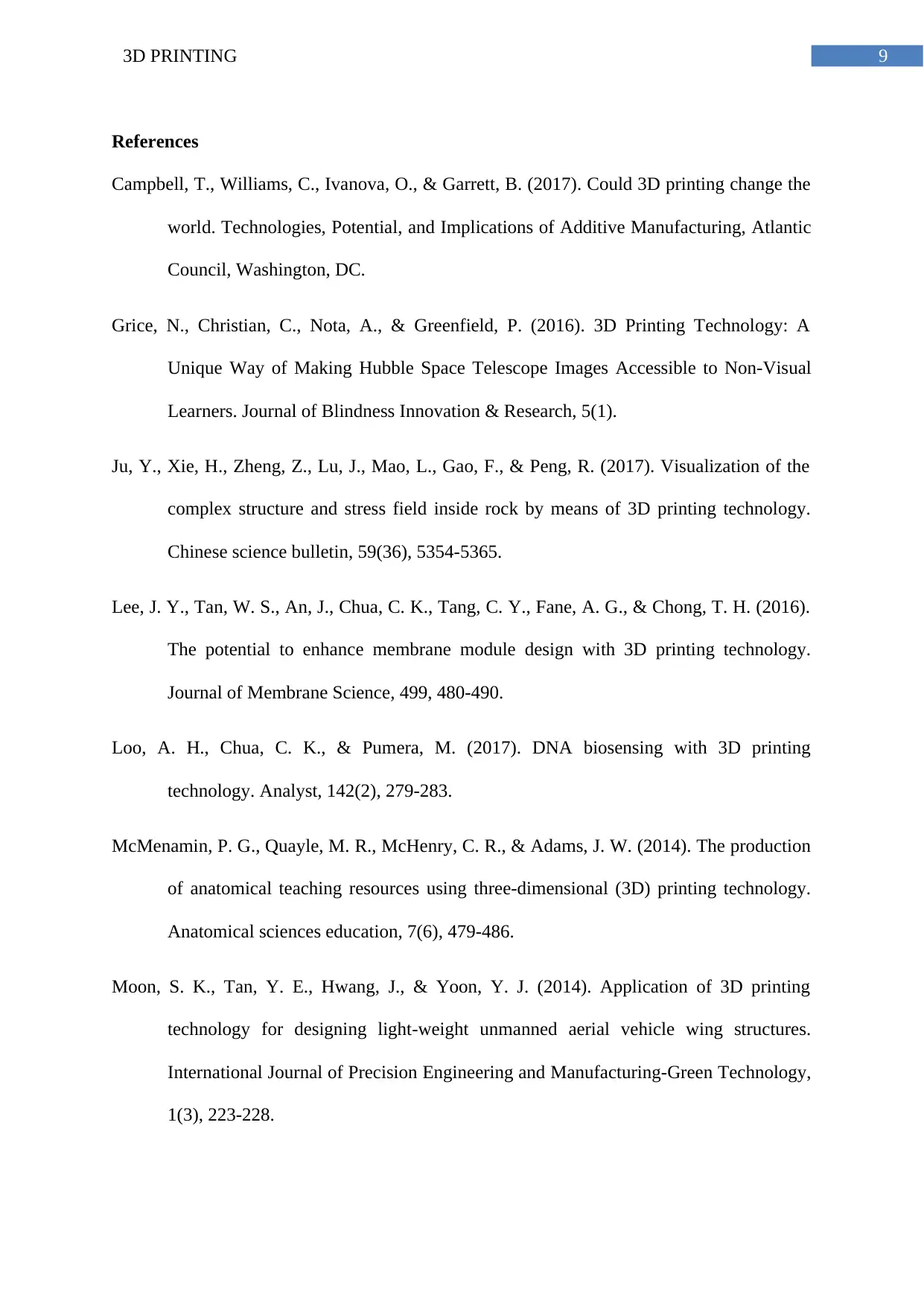
93D PRINTING
References
Campbell, T., Williams, C., Ivanova, O., & Garrett, B. (2017). Could 3D printing change the
world. Technologies, Potential, and Implications of Additive Manufacturing, Atlantic
Council, Washington, DC.
Grice, N., Christian, C., Nota, A., & Greenfield, P. (2016). 3D Printing Technology: A
Unique Way of Making Hubble Space Telescope Images Accessible to Non-Visual
Learners. Journal of Blindness Innovation & Research, 5(1).
Ju, Y., Xie, H., Zheng, Z., Lu, J., Mao, L., Gao, F., & Peng, R. (2017). Visualization of the
complex structure and stress field inside rock by means of 3D printing technology.
Chinese science bulletin, 59(36), 5354-5365.
Lee, J. Y., Tan, W. S., An, J., Chua, C. K., Tang, C. Y., Fane, A. G., & Chong, T. H. (2016).
The potential to enhance membrane module design with 3D printing technology.
Journal of Membrane Science, 499, 480-490.
Loo, A. H., Chua, C. K., & Pumera, M. (2017). DNA biosensing with 3D printing
technology. Analyst, 142(2), 279-283.
McMenamin, P. G., Quayle, M. R., McHenry, C. R., & Adams, J. W. (2014). The production
of anatomical teaching resources using three‐dimensional (3D) printing technology.
Anatomical sciences education, 7(6), 479-486.
Moon, S. K., Tan, Y. E., Hwang, J., & Yoon, Y. J. (2014). Application of 3D printing
technology for designing light-weight unmanned aerial vehicle wing structures.
International Journal of Precision Engineering and Manufacturing-Green Technology,
1(3), 223-228.
References
Campbell, T., Williams, C., Ivanova, O., & Garrett, B. (2017). Could 3D printing change the
world. Technologies, Potential, and Implications of Additive Manufacturing, Atlantic
Council, Washington, DC.
Grice, N., Christian, C., Nota, A., & Greenfield, P. (2016). 3D Printing Technology: A
Unique Way of Making Hubble Space Telescope Images Accessible to Non-Visual
Learners. Journal of Blindness Innovation & Research, 5(1).
Ju, Y., Xie, H., Zheng, Z., Lu, J., Mao, L., Gao, F., & Peng, R. (2017). Visualization of the
complex structure and stress field inside rock by means of 3D printing technology.
Chinese science bulletin, 59(36), 5354-5365.
Lee, J. Y., Tan, W. S., An, J., Chua, C. K., Tang, C. Y., Fane, A. G., & Chong, T. H. (2016).
The potential to enhance membrane module design with 3D printing technology.
Journal of Membrane Science, 499, 480-490.
Loo, A. H., Chua, C. K., & Pumera, M. (2017). DNA biosensing with 3D printing
technology. Analyst, 142(2), 279-283.
McMenamin, P. G., Quayle, M. R., McHenry, C. R., & Adams, J. W. (2014). The production
of anatomical teaching resources using three‐dimensional (3D) printing technology.
Anatomical sciences education, 7(6), 479-486.
Moon, S. K., Tan, Y. E., Hwang, J., & Yoon, Y. J. (2014). Application of 3D printing
technology for designing light-weight unmanned aerial vehicle wing structures.
International Journal of Precision Engineering and Manufacturing-Green Technology,
1(3), 223-228.
⊘ This is a preview!⊘
Do you want full access?
Subscribe today to unlock all pages.

Trusted by 1+ million students worldwide
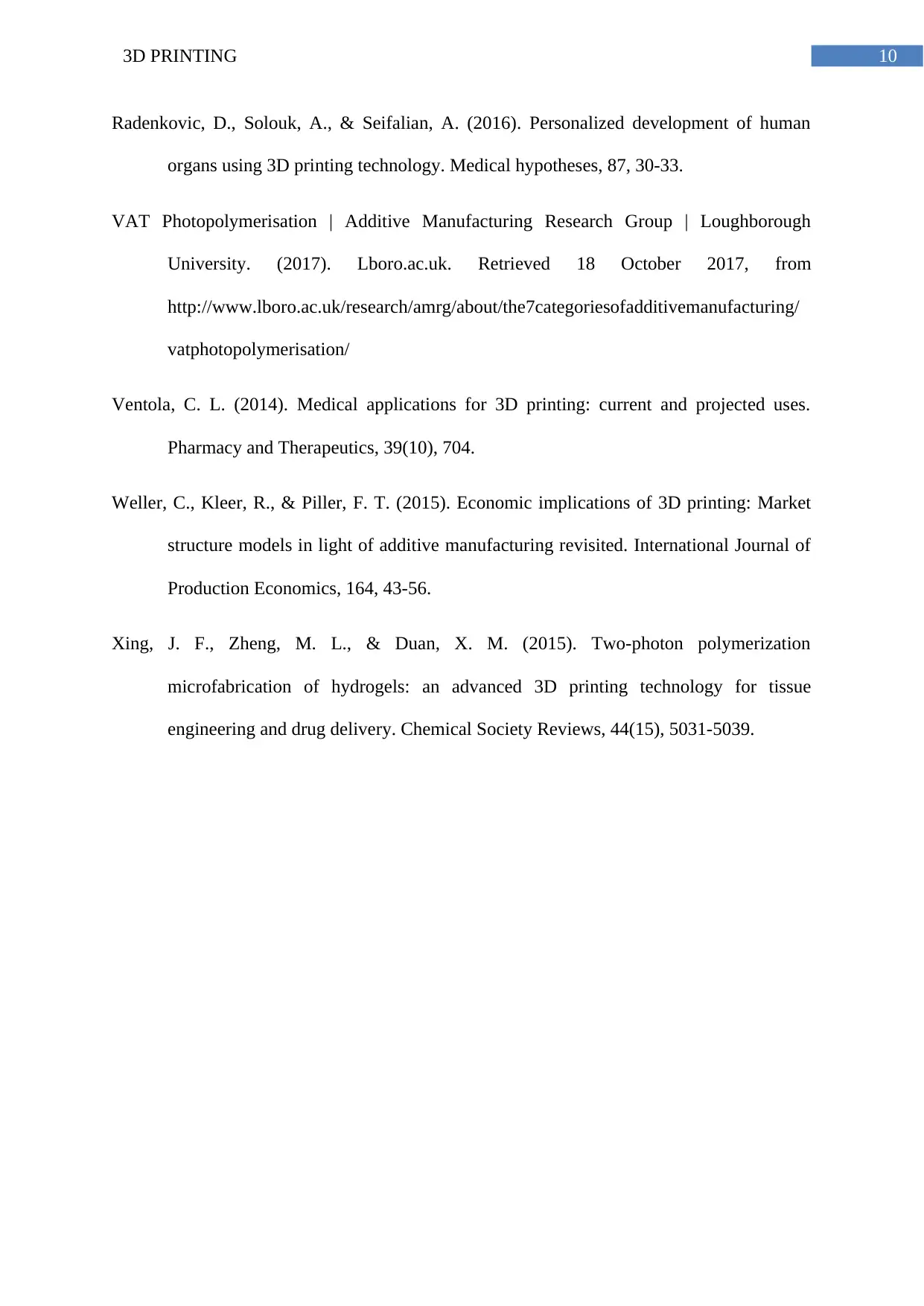
103D PRINTING
Radenkovic, D., Solouk, A., & Seifalian, A. (2016). Personalized development of human
organs using 3D printing technology. Medical hypotheses, 87, 30-33.
VAT Photopolymerisation | Additive Manufacturing Research Group | Loughborough
University. (2017). Lboro.ac.uk. Retrieved 18 October 2017, from
http://www.lboro.ac.uk/research/amrg/about/the7categoriesofadditivemanufacturing/
vatphotopolymerisation/
Ventola, C. L. (2014). Medical applications for 3D printing: current and projected uses.
Pharmacy and Therapeutics, 39(10), 704.
Weller, C., Kleer, R., & Piller, F. T. (2015). Economic implications of 3D printing: Market
structure models in light of additive manufacturing revisited. International Journal of
Production Economics, 164, 43-56.
Xing, J. F., Zheng, M. L., & Duan, X. M. (2015). Two-photon polymerization
microfabrication of hydrogels: an advanced 3D printing technology for tissue
engineering and drug delivery. Chemical Society Reviews, 44(15), 5031-5039.
Radenkovic, D., Solouk, A., & Seifalian, A. (2016). Personalized development of human
organs using 3D printing technology. Medical hypotheses, 87, 30-33.
VAT Photopolymerisation | Additive Manufacturing Research Group | Loughborough
University. (2017). Lboro.ac.uk. Retrieved 18 October 2017, from
http://www.lboro.ac.uk/research/amrg/about/the7categoriesofadditivemanufacturing/
vatphotopolymerisation/
Ventola, C. L. (2014). Medical applications for 3D printing: current and projected uses.
Pharmacy and Therapeutics, 39(10), 704.
Weller, C., Kleer, R., & Piller, F. T. (2015). Economic implications of 3D printing: Market
structure models in light of additive manufacturing revisited. International Journal of
Production Economics, 164, 43-56.
Xing, J. F., Zheng, M. L., & Duan, X. M. (2015). Two-photon polymerization
microfabrication of hydrogels: an advanced 3D printing technology for tissue
engineering and drug delivery. Chemical Society Reviews, 44(15), 5031-5039.
1 out of 10
Related Documents
Your All-in-One AI-Powered Toolkit for Academic Success.
+13062052269
info@desklib.com
Available 24*7 on WhatsApp / Email
![[object Object]](/_next/static/media/star-bottom.7253800d.svg)
Unlock your academic potential
Copyright © 2020–2025 A2Z Services. All Rights Reserved. Developed and managed by ZUCOL.





